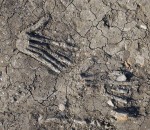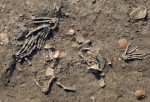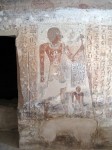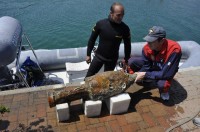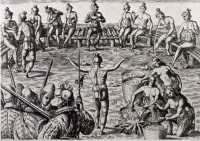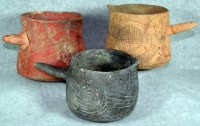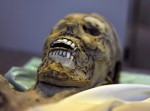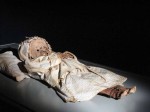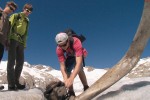 Three 18-year-old hikers have found the propeller from a C-53 Skytrooper Dakota that crashed on the Gauli Glacier in Switzerland’s Bernese Alps on November 19, 1946. The crash was front page news worldwide when it happened, and it’s still famous in Switzerland as the event that pioneered Alpine air rescue.
Three 18-year-old hikers have found the propeller from a C-53 Skytrooper Dakota that crashed on the Gauli Glacier in Switzerland’s Bernese Alps on November 19, 1946. The crash was front page news worldwide when it happened, and it’s still famous in Switzerland as the event that pioneered Alpine air rescue.
On Monday, November 18th, 1946, the U.S. military transport plane departed Vienna en route to Pisa. Hoping to avoid bad weather, the pilot, Captain Ralph Tate Jr., planned a longer route that would take them through Munich and Marseilles and get them to Pisa two days later. They were particularly keen to play it safe since the plane was carrying several high-ranking officers and their family members. The pilot was the son of Brigadier General Ralph Tate, the deputy U.S. commander in Austria, and his mother Mrs. Ralph Tate was a passenger. Also on board were Brigadier General Loyal M. Haynes, head of the advisory board of U.S. forces in Austria, and his wife, Colonel William McMahon, retiring chief of staff of U.S. forces in Austria, his wife and their 11-year-old daughter Mary Alice. The total complement on board was 12 people, including the four-member crew.
 Somewhere around Innsbruck, the pilots became disoriented and went off-course. They knew they were in the Alps because Tate had had to dodge several mountain peaks, but they thought it was the French Alps. When a downdraft sent them towards yet another mountain peak, Tate intentionally dropped the airplane, pancaking it onto the Gauli glacier from an altitude of 10,990 feet. The plane skidded on its belly uphill for short while, mercifully slowed down by a snow bank which caught the wing and kept them from plunging into a deep crevasse just a few hundred feet away. It was Tuesday, November 19th.
Somewhere around Innsbruck, the pilots became disoriented and went off-course. They knew they were in the Alps because Tate had had to dodge several mountain peaks, but they thought it was the French Alps. When a downdraft sent them towards yet another mountain peak, Tate intentionally dropped the airplane, pancaking it onto the Gauli glacier from an altitude of 10,990 feet. The plane skidded on its belly uphill for short while, mercifully slowed down by a snow bank which caught the wing and kept them from plunging into a deep crevasse just a few hundred feet away. It was Tuesday, November 19th.
Tate’s quick action had saved their lives and the only serious injury among the passengers was a compound fracture to the leg, but now the 12 of them were stuck somewhere 10,000 feet up in the Alps in late November. They were able to radio out for help, but the mountains deflected the signal so the B-17 bombers sent by the U.S. military to search for the downed plane were unable to locate it.
 Two days passed, with the survivors subsisting on box lunches and candy bars they’d purchased in Munich. It was cold, like five degrees Fahrenheit cold. They used upholstery from the plane, army blankets and parachutes to wrap themselves in and wood and fuel to keep themselves warm and to melt snow for water. Then it snowed, covering the shiny metal of the airplane and making it even less visible from the sky than it had been before. Before the batteries in the radio ran out, Tate sent out one last message saying that conditions were rough and they had maybe 24 hours to live.
Two days passed, with the survivors subsisting on box lunches and candy bars they’d purchased in Munich. It was cold, like five degrees Fahrenheit cold. They used upholstery from the plane, army blankets and parachutes to wrap themselves in and wood and fuel to keep themselves warm and to melt snow for water. Then it snowed, covering the shiny metal of the airplane and making it even less visible from the sky than it had been before. Before the batteries in the radio ran out, Tate sent out one last message saying that conditions were rough and they had maybe 24 hours to live.
The next day, Friday, November 22nd, a B-29 bomber piloted by none other than General Ralph Tate Sr. passed over the wreck while he was on his way back to Munich from a failed search attempt. Tate Jr. sent up a flare and Tate Sr. responded with a flare of his own. Tate Jr. turned on the radio and heard his father’s voice. He was only able to say “Hi, Dad,” and hear “Hi, Ralph, how…” in reply before the radio died.
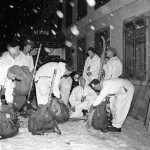 With the coordinates of the crashed plane finally established, the U.S. Army went into full rescue mode. Airplanes dropped packages of food, blankets, padded pants, boots and cigarettes. Many of them ended up down the ravines on either side of the wreck or too deep in the snow to be recovered. The army sent 150 mountain-infantry soldiers with a full complement of jeeps and snowcats to the nearby town of Meiringen, 15 miles east of Interlaken, to rescue the passengers overland, but the Swiss warned them none of those fancy vehicles could manage the Alpine terrain.
With the coordinates of the crashed plane finally established, the U.S. Army went into full rescue mode. Airplanes dropped packages of food, blankets, padded pants, boots and cigarettes. Many of them ended up down the ravines on either side of the wreck or too deep in the snow to be recovered. The army sent 150 mountain-infantry soldiers with a full complement of jeeps and snowcats to the nearby town of Meiringen, 15 miles east of Interlaken, to rescue the passengers overland, but the Swiss warned them none of those fancy vehicles could manage the Alpine terrain.
This was delicate terrain diplomatically as well. During the war, the Swiss Air Force had shot down both Allied and Axis planes flying in its airspace and relations with Switzerland were still frosty, to coin a phrase. The U.S. military was reluctant to leave the mission in Swiss hands, but Alpine rescue requires expertise the U.S. just didn’t have; so they kept their snowcats and jeeps in Meiringen while on Saturday morning at 4:15, the Swiss military sent 80 experienced mountaineers to the wreck site.
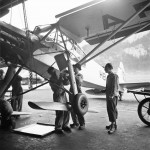 It took them 13 hours of hiking through massive snow banks to reach the crash survivors. When they finally got there, they realized there was no way this ragged and depleted group could manage the trek back to safety. The next day, the morning of Saturday, November 24th, the rescue team and survivors saw two lightweight Fieseler Storch airplanes with skis attached to them flying over the crash site.
It took them 13 hours of hiking through massive snow banks to reach the crash survivors. When they finally got there, they realized there was no way this ragged and depleted group could manage the trek back to safety. The next day, the morning of Saturday, November 24th, the rescue team and survivors saw two lightweight Fieseler Storch airplanes with skis attached to them flying over the crash site.
The planes were an experiment. Their pilots, Captain Victor Hug and Major Pista Hitz, had practiced mountain landings and takeoffs before, but never on a snow-covered glacier. They decided now was the time to try, so they rigged runners to the undercarriage of their planes and took off. They were successful. They were successful nine times, in fact, taking seven hours to fly all the passengers and their baggage to safety in Meiringen.
General Tate met his son and wife at the airport. Captain Tate hugged him, while Mrs. Tate, still in shock, declared she had had “too many airplanes.” Little Alice McMahon, on the other hand, came out of the rescue plane chewing gum and declared, “I’m all right. I had a fine time.”
The next day snow fell and didn’t stop for three days. There is no way they would have survived until conditions allowed another rescue attempt. Most of the mountaineers in the rescue party made their way back on Sunday. Twenty of them spent the night in a cabin and finished the trip the next day.
This daring mission was the first Swiss air rescue but not the last. The Swiss Air Rescue Guard Rega runs helicopters these days, but it still traces its roots to the 1946 Dakota rescue which has achieved quasi-legendary status, especially in the Bernese Alps where it all went down.
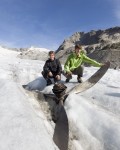 This July, Canadian tourist Lucas Kocher was regaled with the crash story by the chef at his hostel. His two Bernese friends, Manuel Ruefener and Peter Fluehmann, had known about the Dakota since they were children, of course, and since the three of them planned to hike the glacier anyway, they determined to keep their eyes open for debris just in case.
This July, Canadian tourist Lucas Kocher was regaled with the crash story by the chef at his hostel. His two Bernese friends, Manuel Ruefener and Peter Fluehmann, had known about the Dakota since they were children, of course, and since the three of them planned to hike the glacier anyway, they determined to keep their eyes open for debris just in case.
They didn’t actually think they’d find anything. The summer after the rescue, the Swiss army recovered the engines from the airplane, and some visitors were able to collect scraps like the occasional blanket in years after. The bulk of the wreck, however, was lost under snow and ice. People searching with metal detectors have come up empty. The trio was solely equipped for hiking on July 27th when one of them spotted something sticking out of the ice that he thought was a log. Upon approach they realized it was the blade of a propeller. It was dented but in remarkably sound condition considering it crashed and then froze for nigh on seven decades. The gear still turned.
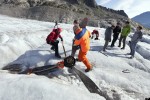 They left the site alone but weren’t sure who to report it to. One of the mothers ended up telling a local television station, and the word got out from there. The exact location was kept under wraps to keep souvenir hunters away before mountain rescuers arrived to recover the remains. There was speculation that the prop might still have been attached to the body of the airplane, but when the rescuers removed the propeller from the ice on August 9th, they found it was on its own about two miles from the original wreck site. Between the crash, human interference, snow and the movement of the glacier over time, whatever is left of the Dakota has scattered.
They left the site alone but weren’t sure who to report it to. One of the mothers ended up telling a local television station, and the word got out from there. The exact location was kept under wraps to keep souvenir hunters away before mountain rescuers arrived to recover the remains. There was speculation that the prop might still have been attached to the body of the airplane, but when the rescuers removed the propeller from the ice on August 9th, they found it was on its own about two miles from the original wreck site. Between the crash, human interference, snow and the movement of the glacier over time, whatever is left of the Dakota has scattered.
The propeller has been transported to the Gauli cabin. No word yet on where it goes from there.

